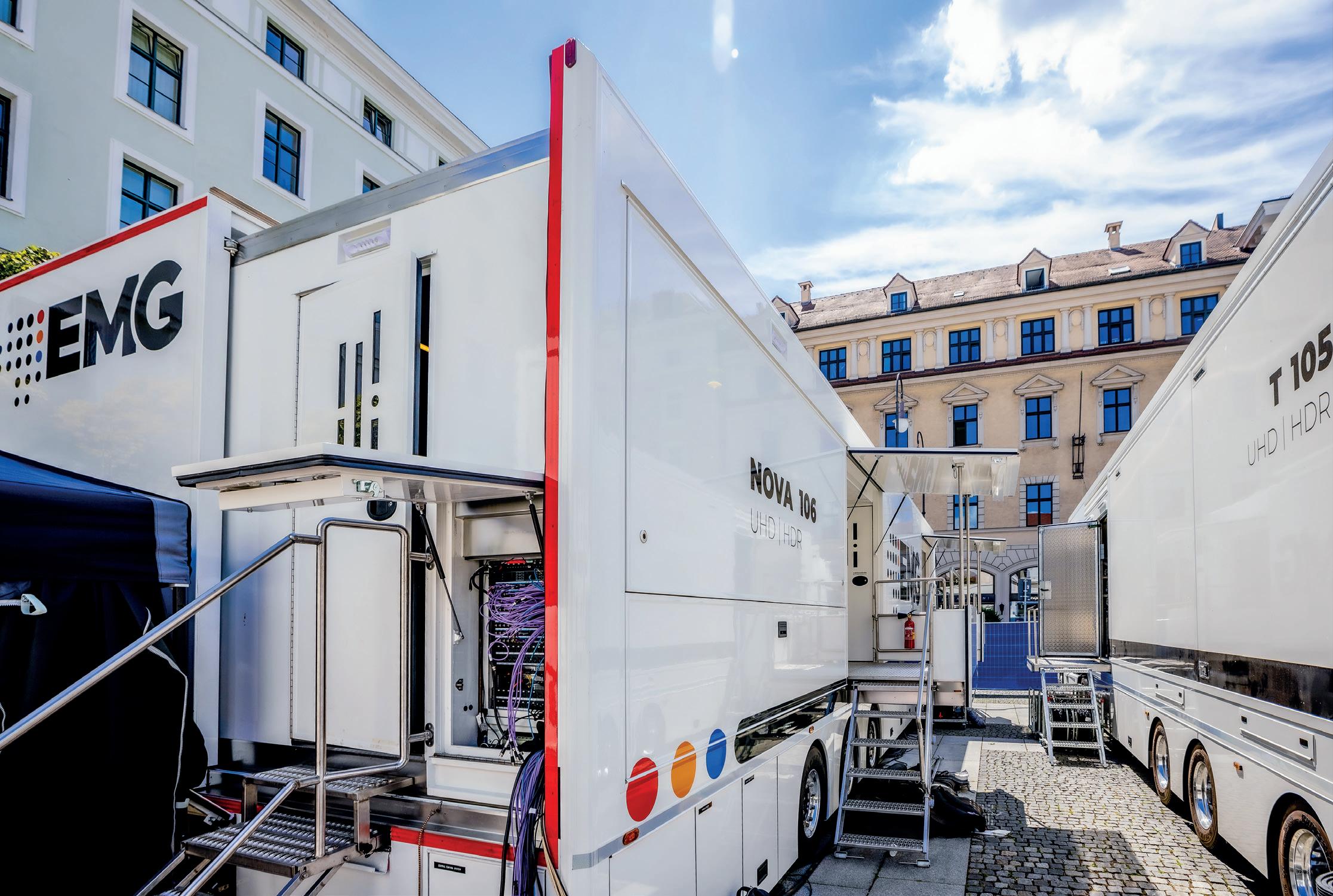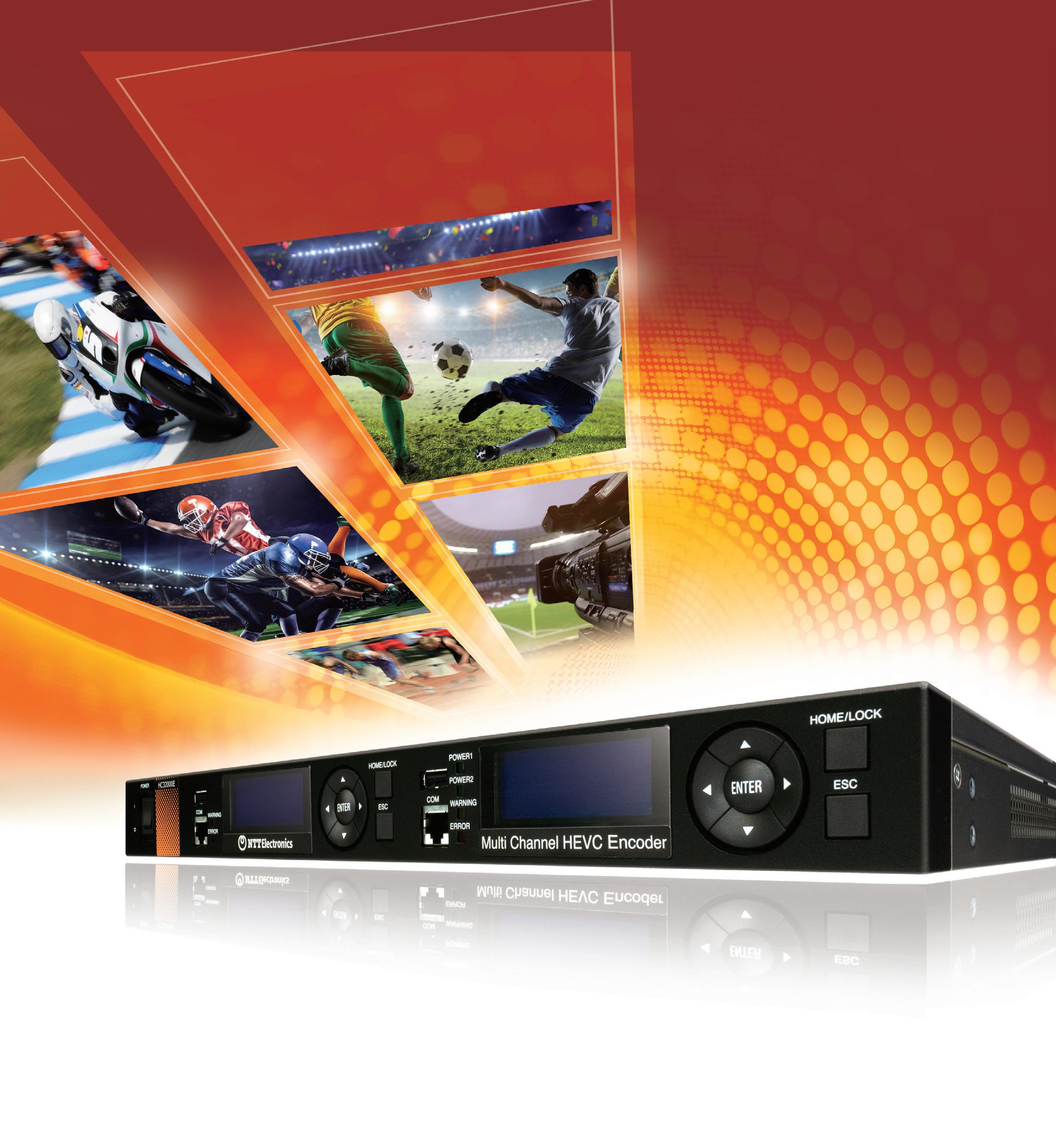
8 minute read
European Championships 2022
EMG drafted in trucks, kit and crew from its divisions across Europe for the multi-sport event Credit: Ben Houdijk
Live from Munich 2022: Inside the European Championships with EMG
BY GEORGE BEVIR
FIRST PUBLISHED 19 AUGUST 2022 W ith the temperature in Munich in the mid30 degrees centigrade, a hosepipe is being used to douse the spectators packed into Königsplatz for the final of the women’s bouldering. Despite the heat, the climbers continue to pick their way across the bouldering wall, while on the other side of the square in front of stands packed with more spectators, preliminary men’s and women’s beach volleyball matches are taking place.
Both sports are part of the nine Olympic events that make up the 2022 European Championships, which brings together the existing championships of some of the continent’s leading sports into one event and also features canoeing, cycling, gymnastics, rowing, table tennis, triathlon and a host of athletics disciplines.
The 11-day European Championships is the biggest multi-sport event to take place in Germany since the 1972 Summer Olympics. EMG is working directly with the Munich 2022 local organising committee (LOC) to provide production facilities in support of the LOC’s host broadcast plans, which include more than 400 hours of live production captured from 12 competition venues. The European Broadcasting Union (EBU), which represents Europe’s free-to-air channels, is the official broadcast partner of the European Championships, with 40 of its free-to-air broadcaster members providing live programming and highlights on more than 50 channels.
Given the scale of the event, EMG has drafted in trucks, kit and crew from its divisions across Europe, which include Germany, the Netherlands, Belgium, France and the UK. Spearheading the operation for EMG is head of international projects and sales Chris Demeulemeester, who led EMG’s bid and is on site in Munich along with some 285 EMG colleagues.
One of the main differences to other multi-sport events is the organisational structure; instead of working to a production company, EMG’s client is the LOC, a group set up by European Championships Management (ECM), the organisation that founded the European Championships and which manages and co-ordinates the event alongside the participating federations and the city of Munich.
While EMG has been tasked with providing technical
and production facilities at the Olympiapark, including galleries, OBs at the venues around Munich, RF provision and asset management, the LOC is responsible for editorial, for example hiring the directors and camera operators under the direction of head of production Joris Wauman. Demeulemeester is also working closely with engineers Norbert Garske and Gerd Kaiser.
Detailed planning
For Demeulemeester, one of the standout aspects of the Championships has been the level of detail for both the tender and the planning of the project.
“I have never received such a precise production plan in my entire career,” he tells SVG Europe from the IBC at the Olympiapark. “The preparation level done by Norbert and Gert, who are the lead engineers on behalf of the LOC, was at an extremely high level. A year and a half before the Championships I already had the entire layouts and camera plans.”
At the heart of the Olympiapark is the Olympiastadion, a striking stadium that was built for the 1972 Summer Games that is being used as the main venue for the athletics. Also taking place at the Olympiapark is the freestyle BMX, mountain bike cross-country, triathlon and gymnastics.
IP flypack system diPloy is housed in two shipping containers on the corner of the IBC. Based on Imagine Communications’ Selenio Network Processor platform, EMG built diPloy for the Olympic Games in Tokyo and tested it at the 2021 FIS Nordic World Ski Championship where it was used to co-ordinate a remote production, with the ski jumping production team situated a few kilometres away from the camera crew on the competition site.
Demeulemeester says that the use of diPloy in Munich means less cabling and fewer hours spent on installation. “We are present in more than 40 containers at the IBC and build up time was just five days, so the speed of the build was enormously fast. Engineering wise, it is enormously complex of course, because the whole infrastructure is IP. We still have lots of legacy into IP, but the core infrastructure is 100% IP-based.”
The second block of EMG’s role at Munich 2022 is a series of more traditional OBs to cover the events taking place around the city of Munich; a few miles south of
The BEST ANSWER to deliver Sporting Events

High Density of 4k x 2ch / HD x 8ch Encoding in 1RU


Multi-Channel HEVC Encoder


HC32000E

CHRIS DEMEULEMEESTER, EMG the Olympiapark the beach volleyball and climbing at Königsplatz, Rudi-Sedlmayer-Halle for the table tennis, and Odeonsplatz for the marathon and race walking. Further afield is Messe München for the track cycling, the Munich Olympic Regatta Centre for the rowing, and outside of Munich the road cycling.
“We have six external OBs for sports that are not able to be hosted at the Olympiapark, and they are working as standalone productions, feeding their lines back to the TOC at the Olympiapark. From here, we do quality control, we reinject feeds to other galleries and we distribute,” says Demeulemeester, adding that signal distribution between the venues and trucks is taken care of by Riedel MicroN technology, which is not part of EMG’s contract.
The third aspect of EMG’s role at the European Championships relates to the provision of wireless connectivity, from short range for roaming cameras at the athletics and rear-facing cameras mounted on bikes at the track cycling handled by EMG group company Broadcast RF, to long-range coverage for events such as the road cycling and marathons.
The fourth and most complicated element of EMG’s role at the Championships, says Demeulemeester, is the media asset management system, which is based on an EVS network in the OB trucks and galleries, with some 54 EVS VIA servers in use.
“The format we are using is 1080p50, so we need the bandwidth,” he says. Other elements of the MAM setup include 30 units of EVS IPDirector for logging of content, along with eight Adobe edit suites plus a cloudbased distribution platform created in partnership with EVS to make all content available to rights holders and partners.
“So with a login, a journalist in the US can browse and search for content and download it in any codec available on any format,” says Demeulemeester. “To run this, we have created a dedicated EMG network, with firewalls around it because of course you need to protect your network. In total, I think we now have 912TB of storage just to run the operation, and at the end of the Championships we will stay here for another 48 hours and upload that content to a temporary archive system.”
Audio over IP used to bring sound to viewers
EMG was responsible for the live broadcast of the European Championships Munich (ECM), and it used an audio over IP (AoIP) set up from Lawo to make it happen.
The nine galleries for the Games at the IBC, located in Munich’s Olympiastadion, plus one gallery for outside venues, were equipped with Lawo mc²56 MkIII production consoles to cover the audio production in the stadium for the athletics, BMX and mountain biking, the Olympiapark for the medal ceremonies, the Olympiahalle for gymnastics, and the remote venues.
Powered by the 1U software-defined A__ UHD audio engine with Home functionality, up to 1,024 mc²-grade DSP channels per processing core can be shared among multiple consoles. This pooling option was applied to the ECM installation as a whole; instead of dedicated audio cores, the required processing power for all mixing consoles was derived from a cluster of eight shared A__UHD audio engines in a redundant setup, supporting flexible DSP assignment and reliability.
For further increased security, docker containers in an also redundantly designed cluster of six servers hosted the mirrored software of the audio mixers, so if any gallery should have gone down, the whole system would have stayed functional and the audio mixing could have still been handled outside the console.
For audio contribution, the set up comprised more than 30 Lawo AoIP stageboxes of the A__line WAN-capable AoIP nodes. Employed were clusters of A__stage64 and A__stage 48, as well as A__madi4 and A__madi6 plus A__ mic8 units, dedicated to tournaments and ECM events. Thirty-five Lawo C100 blades were in use for 130 multiviewer heads.
Guy Haegeman, EMG multicam audio engineer, stated: “EMG’s sports production services for the European Championships were certainly an outstanding event. Many tournaments were running in parallel. We had to cover them either in one location from different spots or in different locations. This meant that during the whole event we had to deal with an immense number of parallel feeds that needed to be monitored, switched and produced.”

Credit: Ben Houdijk Lawo mc²56 MkIII production consoles were chosen to cover the audio production in the Olympiahalle for gymnastics as well as other venues










